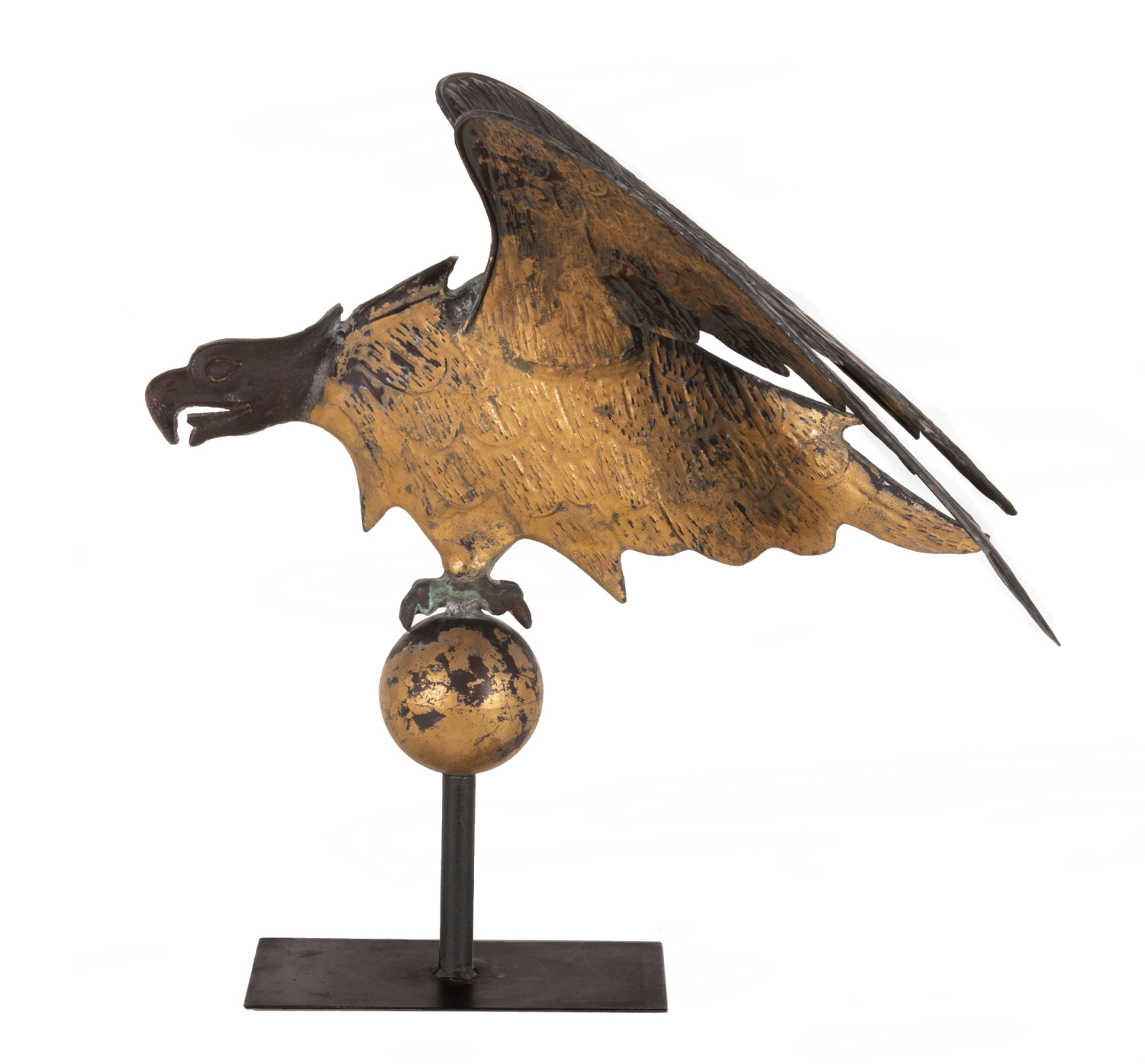
| |
EAGLE WEATHERVANE IN A BEAUTIFUL FORM WITH GREAT FOLK PRESENCE, POSSIBLY MADE BY A.L. JEWELL & CO. (1852-1867) OR ITS PREDECESSOR, CUSHING & WHITE / L.W. CUSHING (1867-1870’s), WALTHAM, MASSACHUSETTS |
| |
|
| Dimensions (inches): |
22" h x 14" w at wings x 23" d beak-to-tail |
| Description: |
|
Eagle weathervane, made of hammered copper with a cast iron head and talons, in a beautifully stylized, war-like form. The narrow, hollow body form is comprised of two mirror image sides, in typical fashion, with single sheet copper wings applied, bent as if poised for takeoff. With beak open and a curved tongue, the majestic bird is positioned as if perched on the copper ball beneath.
This basic form is universally attributed to A.L. Jewell & Co. of Waltham, Massachusetts, active 1852-1867, and known to have been produced in five sizes, measuring between 17 and 51 inches in length (Massachusetts Capital development Fund, Annual Report, 1979). According to American folk art expert Bob Bishop and co-author Patricia Coblentz (A Gallery of American Weathervanes & Whirleygigs, 1984 edition, Bonanza Books / Crown Publishers, p. 51), a similar form, slightly downward-facing, is known to have been produced in the 3rd quarter of the 19th century by Boston Metal-Workers Company.
The reality is that weathervane makers copied one-another extensively and maker’s marks were in no way standard practice. Of the three similar examples illustrated in weathervane reference text, two by Bishop & Coblentz (p. 50 & 51) and one by Charles Klamkin (Weathervanes, 1973, Hawthorne Books, New York, p. 88), none are alike. Two appear to be slightly downward-facing, yet two are attributed to A.L. Jewell and one to Boston Metal-Workers Co. The example I am offering here, a known form that I have occasionally encountered, is not precisely like any of the above, though usually attributed to Jewell, who, if nothing else, can at least be said to have probably come up with the original design. Jewell was in on the ground floor of commercial weathervane production. This was a transitional period, bridging the gap between when weathervanes were largely singular and bench-made by anyone that could, during the first half of the 19th century and prior, and the emergence of large firms that mass-produced in the last quarter of the 19th century and afterwards. Jewell pioneered that field. In 1867, when Jewell and a business associate were killed in a work-related accident, the firm was acquired by Leonard Cushing, a civil engineer from Providence, Rhode Island, and Stillman White, a machinist. Both were of Waltham originally and took the opportunity to return. White left the company not long after and L.W. Cushing became the new name in 1872. While I have not encountered the form attributed to Cushing & White or featured in Cushing catalogues, it is certainly conceivable that the form continued to be produced, as the two men bought the designs with the business.
Condition: The iron has rusted and obtained a dark patina that is especially attractive in how it contrasts with the gilded surface. The gilding on the body may be the original surface. That on the underside of the wings appears to be what remains of in- service gilt paint, not unlike like that used on the stars of military flags during the second half of the 19th century. The saturated shade of gold is especially great, as-is the wear on the body and ball. The tops of the wings retain no gilding and there are losses elsewhere throughout. |
|
|
| |
|
| Primary Color: |
gold |
|
| Earliest Date: |
1852 |
|
| Latest Date: |
1885 |
|
| For Sale Status: |
Sold |
|
| Price |
SOLD |
|
| E-mail: |
info@jeffbridgman.com |
|
 |
|
Page Views:... 1232 |
|


